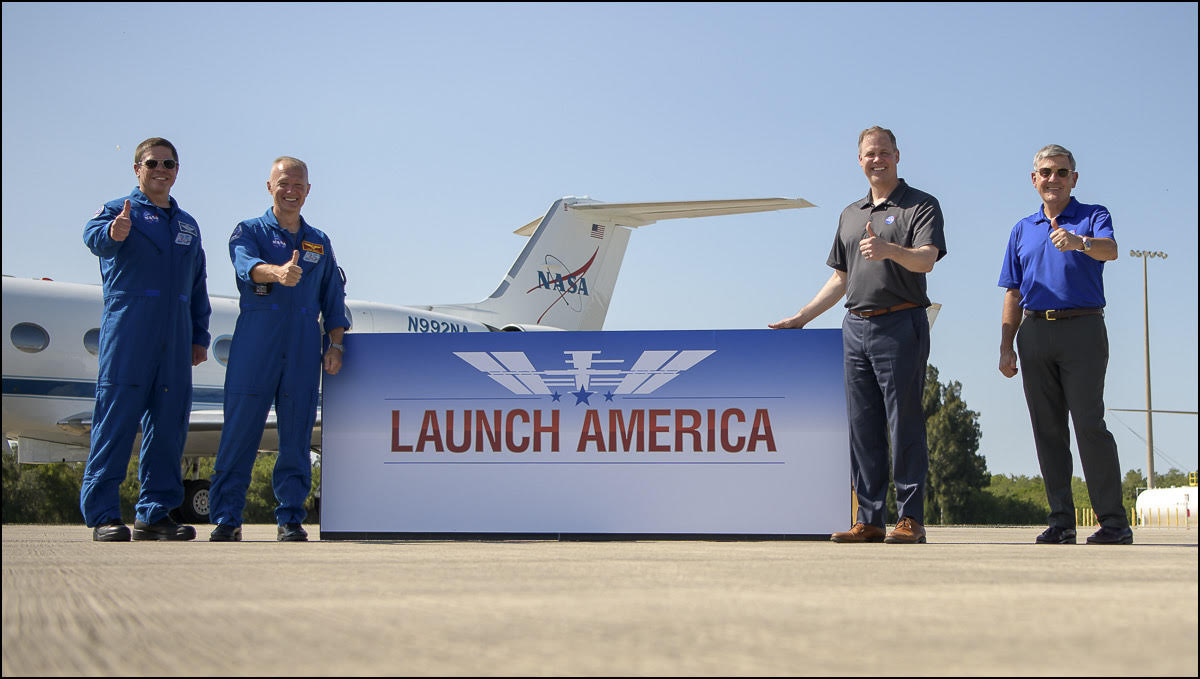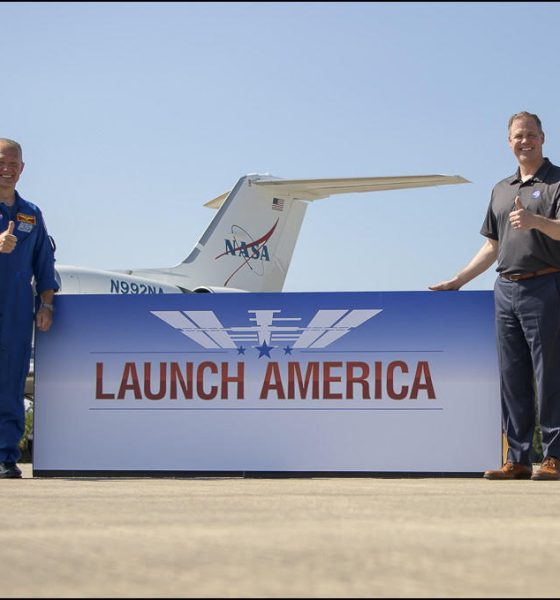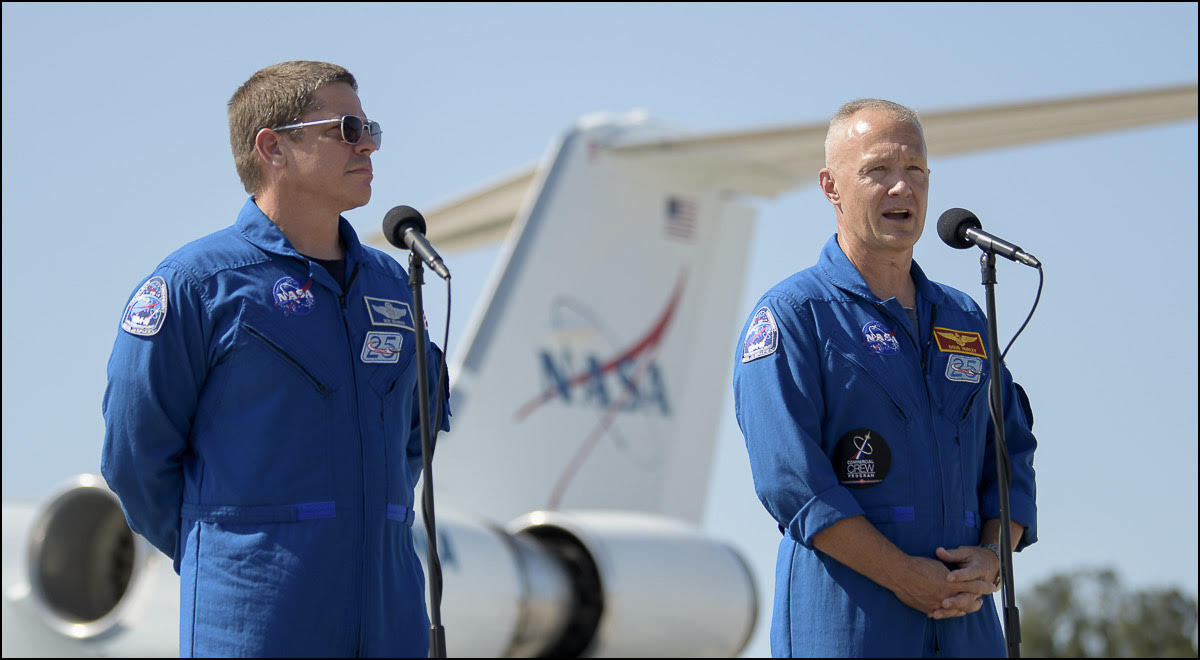

News
SpaceX crewed launch imminent as NASA astronauts arrive at Kennedy Space Center
There are just seven days until human spaceflight returns to U.S. soil. In advance of the historic launch, NASA astronauts Bob Behnken and Doug Hurley boarded an agency plane bound for Kennedy Space Center today (May 20). The duo arrived at the Shuttle Landing Facility at approximately 4 p.m. EDT.
The duo will spend the next several days preparing for their mission to the International Space Station, which will last between 1-4 months.
Astronauts for the #DM2 launch, @AstroBehnken and @Astro_Doug have arrived at the Shuttle Landing Facility to begin final preparations leading up to their launch on the #SpaceX #Falcon9! pic.twitter.com/9rzb2wyDDe
— Richard Angle (@RDAnglePhoto) May 20, 2020
Behnken and Hurley have been under a mission-related quarantine that all astronauts participate in prior to launch. In order to spend some time with the pair prior to liftoff, Behnken and Hurley’s families have also been under strict quarantine and will arrive at the launch site a few days before take-off. It also prevents the crew from bringing any transmittable diseases to the other astronauts currently living and working on the space station.
Behnken and Hurley answered a few questions upon their arrival, explaining that they were excited and very humbled to be a part of the commercial crew program. Hurley and Behnken are both veterans of the space shuttle program, with Hurley having flown on the final flight of the space shuttle Atlantis in 2011.
“I didn’t expect to fly again after STS-135,” Hurley told members of the media.
“Thanks to the SpaceX teams from across the country who have worked hard to make this happen,” he added.

Behnken chimed in: “If you gave us one thing to put on our list of dream jobs, it would have been to be onboard a new spacecraft.”
The duo explained that there would be one final dress rehearsal where the crew will practice entering the Crew Dragon spacecraft as well as try on their spacesuits one last time.
The flight is scheduled to take off on May 27, at 4:33 pm EDT (2033 UTC). Everything is on track so far, but there is still a lot of work left to do before liftoff can occur.
On Thursday, May 21, NASA and SpaceX will conduct a flight readiness review system to evaluate the Crew Dragon and deem it ready for flight. If the vehicle passes that, then on Friday, a static fire test will occur, followed by a crew dress rehearsal. On Monday, NASA will hold its final launch readiness review. If all goes as planned, Bob and Doug will board their spacecraft approximately three hours before launch.

They will spend 19 hours on orbit, testing out various systems on the Crew Dragon spacecraft. At that point, autopilot will take over, and the spacecraft will dock with the space station.
This week the head of NASA’s human exploration program abruptly resigned after being on the job for six months. He was supposed to lead the agency’s flight readiness review, but that will now be handled by the agency’s associate administrator Steve Jurczyk.
Former astronaut and current deputy associate administrator of human exploration Kenneth Bowersox will take over for the departed Doug Loverro. According to NASA, Loverro’s departure will not have an effect on the upcoming crew launch.

News
Tesla (TSLA) receives “Buy” rating and $551 PT from Canaccord Genuity
He also maintained a “Buy” rating for TSLA stock over the company’s improving long-term outlook, which is driven by autonomy and robotics.

Canaccord Genuity analyst George Gianarikas raised his Tesla (NASDAQ:TSLA) price target from $482 to $551. He also maintained a “Buy” rating for TSLA stock over the company’s improving long-term outlook, which is driven by autonomy and robotics.
The analyst’s updated note
Gianarikas lowered his 4Q25 delivery estimates but pointed to several positive factors in the Tesla story. He noted that EV adoption in emerging markets is gaining pace, and progress in FSD and the Robotaxi rollout in 2026 represent major upside drivers. Further progress in the Optimus program next year could also add more momentum for the electric vehicle maker.
“Overall, yes, 4Q25 delivery expectations are being revised lower. However, the reset in the US EV market is laying the groundwork for a more durable and attractive long-term demand environment.
“At the same time, EV penetration in emerging markets is accelerating, reinforcing Tesla’s potential multi‑year growth runway beyond the US. Global progress in FSD and the anticipated rollout of a larger robotaxi fleet in 2026 are increasingly important components of the Tesla equity story and could provide sentiment tailwinds,” the analyst wrote.
Tesla’s busy 2026
The upcoming year would be a busy one for Tesla, considering the company’s plans and targets. The autonomous two-seat Cybercab has been confirmed to start production sometime in Q2 2026, as per Elon Musk during the 2025 Annual Shareholder Meeting.
Apart from this, Tesla is also expected to unveil the next-generation Roadster on April 1, 2026. Tesla is also expected to start high-volume production of the Tesla Semi in Nevada next year.
Apart from vehicle launches, Tesla has expressed its intentions to significantly ramp the rollout of FSD to several regions worldwide, such as Europe. Plans are also underway to launch more Robotaxi networks in several more key areas across the United States.
News
Waymo sues Santa Monica over order to halt overnight charging sessions
In its complaint, Waymo argued that its self-driving cars’ operations do not constitute a public nuisance, and compliance with the city’s order would cause the company irreparable harm.

Waymo has filed a lawsuit against the City of Santa Monica in Los Angeles County Superior Court, seeking to block an order that requires the company to cease overnight charging at two facilities.
In its complaint, Waymo argued that its self-driving cars’ operations do not constitute a public nuisance, and compliance with the city’s order would cause the company irreparable harm.
Nuisance claims
As noted in a report from the Los Angeles Times, Waymo’s two charging sites at Euclid Street and Broadway have operated for about a year, supporting the company’s growing fleet with round-the-clock activity. Unfortunately, this has also resulted in residents in the area reportedly being unable to sleep due to incessant beeping from self-driving taxis that are moving in and out of the charging stations around the clock.
Frustrated residents have protested against the Waymos by blocking the vehicles’ paths, placing cones, and “stacking” cars to create backups. This has also resulted in multiple calls to the police.
Last month, the city issued an order to Waymo and its charging partner, Voltera, to cease overnight operations at the charging locations, stating that the self-driving vehicles’ activities at night were a public nuisance. A December 15 meeting yielded no agreement on mitigations like software rerouting. Waymo proposed changes, but the city reportedly insisted that nothing would satisfy the irate residents.
“We are disappointed that the City has chosen an adversarial path over a collaborative one. The City’s position has been to insist that no actions taken or proposed by Waymo would satisfy the complaining neighbors and therefore must be deemed insufficient,” a Waymo spokesperson stated.
Waymo pushes back
In its legal complaint, Waymo stated that its “activities at the Broadway Facilities do not constitute a public nuisance.” The company also noted that it “faces imminent and irreparable harm to its operations, employees, and customers” from the city’s order. The suit also stated that the city was fully aware that the Voltera charging sites would be operating around the clock to support Waymo’s self-driving taxis.
The company highlighted over one million trips in Santa Monica since launch, with more than 50,000 rides starting or ending there in November alone. Waymo also criticized the city for adopting a contentious strategy against businesses.
“The City of Santa Monica’s recent actions are inconsistent with its stated goal of attracting investment. At a time when the City faces a serious fiscal crisis, officials are choosing to obstruct properly permitted investment rather than fostering a ‘ready for business’ environment,” Waymo stated.
News
Tesla FSD v14.2.2 is getting rave reviews from drivers
So far, early testers have reported buttery-smooth drives with confident performance, even at night or on twisty roads.

Tesla Full Self-Driving (Supervised) v14.2.2 is receiving positive reviews from owners, with several drivers praising the build’s lack of hesitation during lane changes and its smoother decision-making, among others.
The update, which started rolling out on Monday, also adds features like dynamic arrival pin adjustment. So far, early testers have reported buttery-smooth drives with confident performance, even at night or on twisty roads.
Owners highlight major improvements
Longtime Tesla owner and FSD user @BLKMDL3 shared a detailed 10-hour impression of FSD v14.2.2, noting that the system exhibited “zero lane change hesitation” and “extremely refined” lane choices. He praised Mad Max mode’s performance, stellar parking in locations including ticket dispensers, and impressive canyon runs even in dark conditions.
Fellow FSD user Dan Burkland reported an hour of FSD v14.2.2’s nighttime driving with “zero hesitations” and “buttery smooth” confidence reminiscent of Robotaxi rides in areas such as Austin, Texas. Veteran FSD user Whole Mars Catalog also demonstrated voice navigation via Grok, while Tesla owner Devin Olsen completed a nearly two-hour drive with FSD v14.2.2 in heavy traffic and rain with strong performance.
Closer to unsupervised
FSD has been receiving rave reviews, even from Tesla’s competitors. Xpeng CEO He Xiaopeng, for one, offered fresh praise for FSD v14.2 after visiting Silicon Valley. Following extended test drives of Tesla vehicles running the latest FSD software, He stated that the system has made major strides, reinforcing his view that Tesla’s approach to autonomy is indeed the proper path towards autonomy.
According to He, Tesla’s FSD has evolved from a smooth Level 2 advanced driver assistance system into what he described as a “near-Level 4” experience in terms of capabilities. While acknowledging that areas of improvement are still present, the Xpeng CEO stated that FSD’s current iteration significantly surpasses last year’s capabilities. He also reiterated his belief that Tesla’s strategy of using the same autonomous software and hardware architecture across private vehicles and robotaxis is the right long-term approach, as it would allow users to bypass intermediate autonomy stages and move closer to Level 4 functionality.








